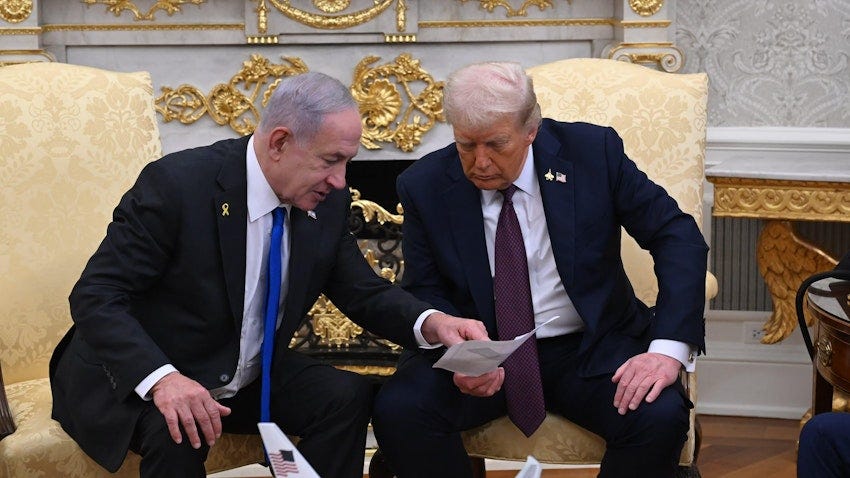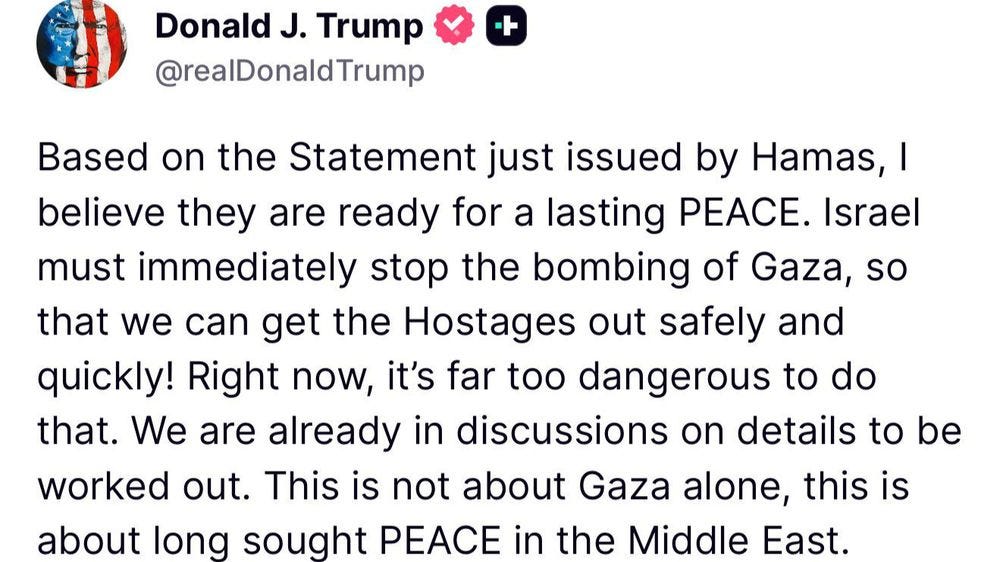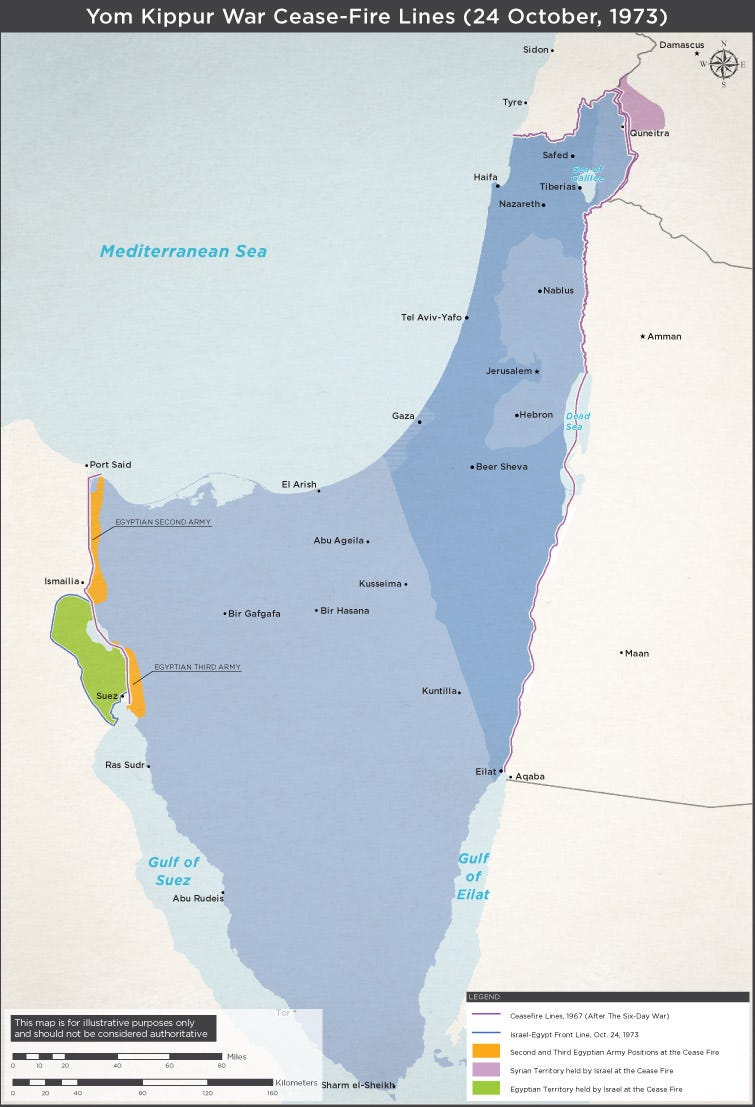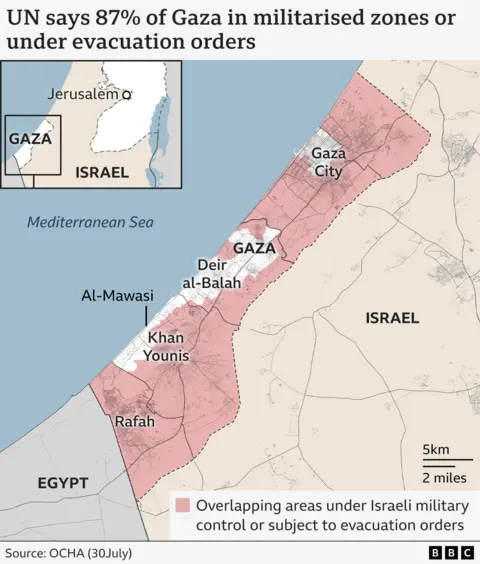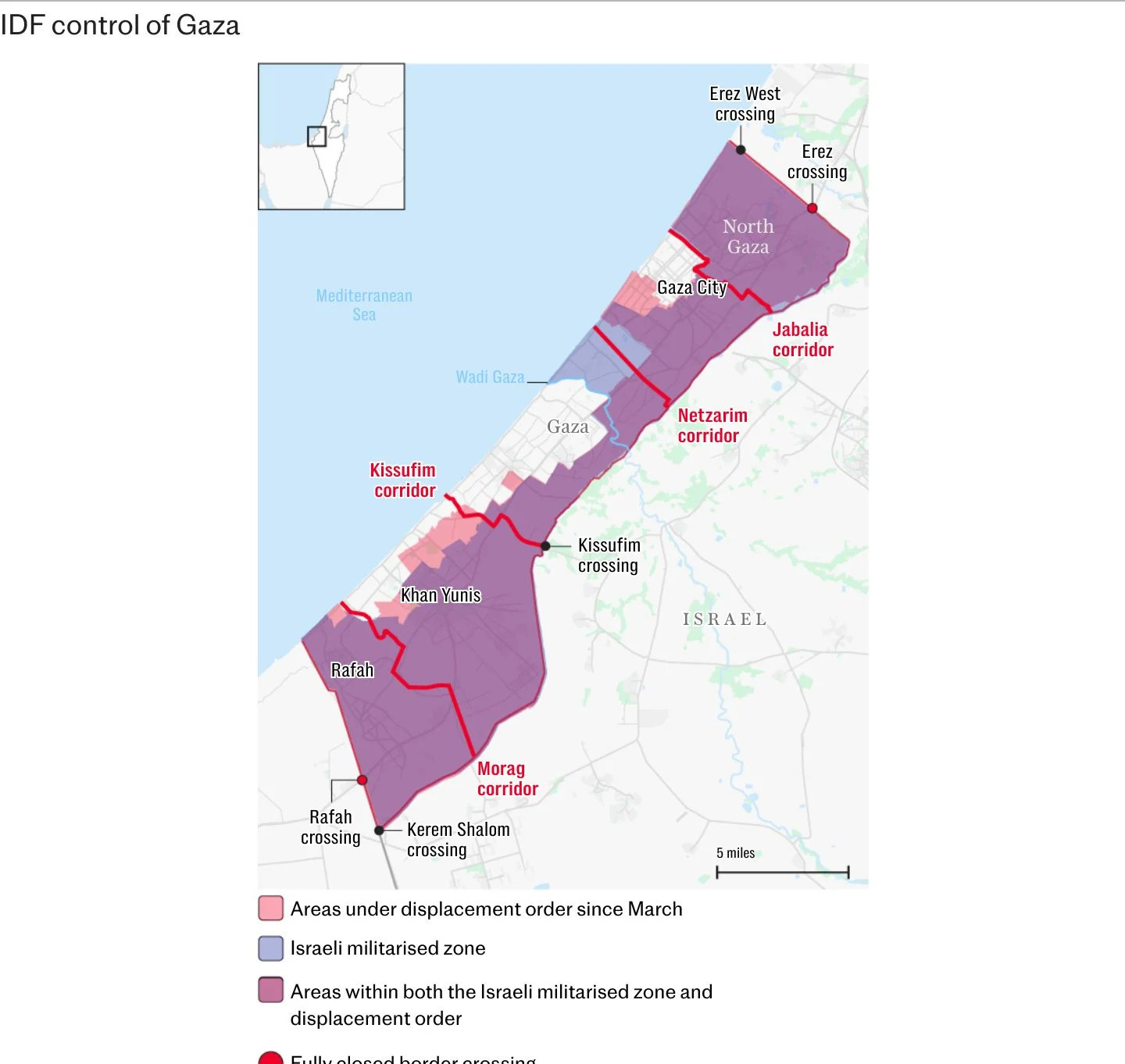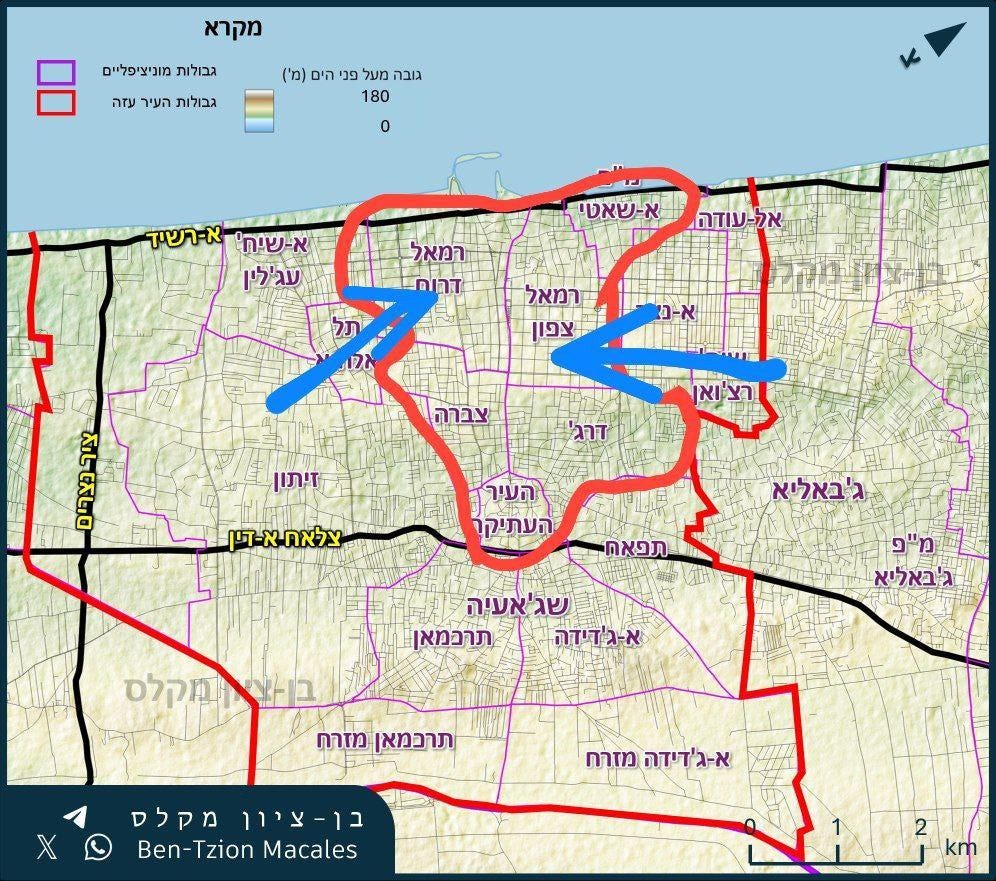Why Now? The Trump "Kissinger" Moment that forced Israel's, Hamas' and Qatar's hand.
The domino effect of the leverage started by Israel's attack on Doha
I write this piece a day or less before the long awaited hostage release, under a recent Trump brokered deal. As pressure built up for Israel to accept the deal, I penned this previous piece with the greatest trepidation.
Unfortunately, the piece correctly saw that unlike under a hundred similar headlines prior, this time Bibi was heading towards agreement. Indeed, while Bibi accepted Trump’s plan in principal (which for Israel, if executed, is horrendous, and may cover that later), Hamas did not and instead “counter-offered”.
The counteroffer was indeed phrased as an acceptance and Trump immediately and publicly (in social media) pressured Israel to accept the revised counter offer.
The statement that the President was referring to, contradicting many core points of his plan. In reads in part:
In the Name of Allah, the Most Gracious, the Most Merciful
In an effort to halt the aggression and war of extermination being waged against our steadfast people in the Gaza Strip, and based on national responsibility and concern for the fundamentals, rights, and supreme interests of our people, the Islamic Resistance Movement (Hamas) has held in-depth consultations within its leadership institutions…
In this context, and in order to achieve a cessation of hostilities and a complete withdrawal from the Gaza Strip, the movement announces its agreement to release all Israeli prisoners, both living and dead, according to the exchange formula contained in President Trump’s proposal, provided the field conditions for the exchange are met. In this context, the movement affirms its readiness to immediately enter into negotiations through the mediators to discuss the details of this agreement.
The movement also renews its agreement to hand over the administration of the Gaza Strip to a Palestinian body of independents (technocrats), based on Palestinian national consensus and Arab and Islamic support.
The other issues mentioned in President Trump’s proposal regarding the future of the Gaza Strip and the inherent rights of the Palestinian people are linked to a comprehensive national position and based on relevant international laws and resolutions. They are to be discussed within a comprehensive Palestinian national framework. Hamas will be part of it and will contribute to it with full responsibility.
Firstly, even the “immediate release of all hostages” is qualified, and requires “field conditions” which means Israeli withdrawals. This directly contradicted Trump’s final offer/ultimatum. More importantly, the statement merely “affirms its readiness to immediately enter into negotiations..”.
It importantly does not mention disarming, which is the arguably the most important Israeli demand in the plan along with the release of the hostages. It vaguely alludes to being willing to “hand over the administration of the Gaza strip to a Palestinian body of independents (technocrats), based on Palestinian national consensus and Arab and Islamic support”.
Of note here first is of course that this handover (to “independents”, meaning not to any rival political factions), is based on “Palestinian national consensus…” etc. Hamas overwhelmingly won the strip’s last election and at least until recently was massively popular among the population (despite Israel’s endless and misguided efforts to speak about Hamas as if it was an alien group that somehow descended among the Gazan population and implemented a tyranny over them. Much like how the US never understood that the Taliban ARE the Afghanis (the majority Pashtuns anyway)). So here Hamas (or whatever they rebrand to) will remain in power as long as the population wishes it to.
Much more interestingly though, this second part of the so called agreement is not an agreement at all. It simply notes that the movement “renews” its agreement to the above referenced handover to independent technocrats. Hamas is saying, as we said before, we said before. This echoes a couple of things. Firstly, on August 2025 statement which read in part:
Hamas said today it was still awaiting a response “to the proposal presented to the movement by mediators on August 18, which was accepted by Hamas and the Palestinian factions.
“In this context, the movement reaffirms its readiness to move toward a comprehensive deal under which all enemy prisoners held by the resistance would be released in exchange for an agreed number of Palestinian prisoners held by the occupation, within an agreement that ends the war on the Gaza Strip, guarantees the withdrawal of all occupation forces from the entire Strip, reopens the crossings for the entry of all essential needs and launches the reconstruction process.”
Hamas added that it had agreed to “the formation of an independent national administration composed of technocrats to immediately assume responsibility for managing all affairs of the Gaza Strip across every sector.”
Israeli Prime Minister Benjamin Netanyahu rejected Hamas’ statement, calling it “spin”, and added through his office that:
The war can end immediately under the conditions set by the Cabinet: the release of all hostages, dismantling of Hamas’ weapons, demilitarization of Gaza, Israeli security control in Gaza, and establishment of an alternative civilian government that does not educate for terrorism, does not dispatch terrorism, and does not threaten Israel.
So we see that not too long ago, Netanyahu was quite willing and able to reject a very similar arrangement with Hamas, and instead ordered the IDF to complete the conquest of the northern strip including Gaza city. What changed? Keep that in mind as we will return to this shortly.
For now, what it means is that clearly Hamas simply reiterated its previous offer of handing over administration to technocrats, and certainly does not mention nor include disarming. Furthermore, even this is tied to complete withdrawal from the strip, reopening of the crossings and so forth. This framework echoes periodic Hamas statements going back to the 2012 Fatah–Hamas Doha / Cairo agreements which included the same independent technocrat language, but in no way do they include the disarmament of Hamas.
So, the Hamas official statement was certainly not an acceptance of the Trump ultimatum. It was a cleverly worded repudiation of it in fact. And yet, as we discussed previously and I feared, Trump took it as an acceptance on successfully pressured Israel to accept it?
How? What changed that allowed the US to do this?
Much like I have written for a long time, and as we discussed above, Hamas was and would be willing to release all the hostages for the end of the war along with a complete Israeli withdrawal (ie Israeli defeat). At this dire point, they were even willing to entertain some sort of technocrat administration, that at least nominally runs Gaza. But until now, Bibi, not wishing for an Israeli defeat, had been able to deftly avoid any such deal. I have described this since the outset of the war 2 years ago as the virtually unbridgeable fundamental par between the two positions that made a deal very difficult.
On the Gazan side however, a subtle but very important shift occurred as well. Hamas was previously willing to to tie the release of the remaining hostages to the physical steps in ending the war. It meant a slow, painful and uncertain process (for Israelis desperately wanting the hostages released). Since all Hamas wanted was the end of the war and full Israeli withdrawal, it hardly would serve its purposes to release all the hostages (all of it leverage), and then simply have Israel restart the war at its leisure. Netanyahu showed twice before that he could and would, restart hostilities.
Netanyahu had previously rebuffed this very similar framework, and Hamas would never agree to a full and immediate release of hostages (alive and dead) before all sorts of withdrawals and guarantees are facts on the ground. A pivotal event changed the situation, put both parties off balance, and gave the US administration the fulcrum it needed to bend the parties to its will and bridge the gap.
Who was bent more?
Well when it comes to the 20 point peace plan that Israel (or at least Netanyahu) vaguely has accepted in principal as something to negotiate towards, it is Israel that has been badly bent. The plan, which I may briefly cover later, if actually implemented significantly or fully is a nightmare scenario for Israel as the ending for the war that began with the savage and murderous Oct 7th (2023) invasion. It would also indicate a complete Israel defeat, and vindicate as correct, intelligent and courageous the surprise invasion and associated barbarism as what is needed to achieve national goals vis-à-vis Israel.
For Hamas, it also entails a few painful conditions, but mostly no more than cosmetic… it is really no more than the movement or political party’s name that need change. They lose 0 territory, gain the promise of increased territory, the path and promise to a state, and guarantees of massive aid, wealth transfers and special trade deals.
But all of that is in yet to be negotiated let alone agreed upon subsequent parts of the deal. In the only agreed upon parts of the deal, the immediate release of hostages in exchange for a partial Israeli withdrawal and release of about Arab 2,000 prisoners, 250 of which are nearly all terrorists convicted of heinous crimes serving life sentences, it is Hamas that bent the most by far.
Hamas has at least agreed to do what it previously would never have considered. Giving up all its remaining human shields, dead or alive, immediately and in one phase.
The Kissinger Moment.
The leverage that allowed the Trump administration to achieve this was born the instant Israel’s jetfighters released their missiles over the Red Sea aimed at Doha Qatar.
Since the outset of the war I have written about how Hamas’ Oct 7 invasion reminded me in so many ways to Sadat’s surprise Egyptian invasion of Israel in the 1973 Yom Kippur War. Won’t rehash it here, but sufficed to say that the strategic and political motivations were very similar as was the execution in many ways (the two were of course not similar in terms the acts of murder, acts of terror and atrocities against women, children and the elderly that the Oct 7 invasion included of course).
Sadat knew that he need only not lose the war. Unlike his predecessor Nasser, he did not have delusions of driving his tank divisions up to Tel-Aviv; he knew that was beyond his reach. Rather than bravado and bluster followed by defeat, an often favored Arab tactic, under General Shazly’s (the Chief-of-Staff) excellently organized plan, Egypt would cross the Suez and hold a piece of Israeli territory under their anti-air and anti-tank missile umbrella.
Sadat figured, correctly as it turned out, that merely doing that would unleash a political process that would end with his reclaiming of the Sinai. Ultimately, he succeeded, and was murdered by Egyptian Salafi Jihadis for his efforts. But before that political process, he needed his victory, or at least his non-defeat in the war as we explained.
The IDF, surprised, bruised, battered but certainly not defeated, regained its confidence and IDF forces (under General Ariel Sharon) crossed the Suez canal (through the gap between the 2nd and 3rd Egyptian armies), opened a corridor and allowed 2 additional Armored divisions to cross into “Africa” from Sinai. These forces, through heroic efforts (racing against the clock of a UN Security Council imposed Ceasefire) surrounded the third army from its rear. Sharon’s Division, moved north and partially cut off the Second Army. Egypt’s exhausted and battered 3rd army was a day or two (if not hours) from surrender without water, food or supply, and subsequent to that, with the Israeli divisions unleashed in the south, the fate of the second army would be no different. Fully surrounded and forced to surrender.
The catastrophe that the war would have been for Egypt, and Sadat in particular, is hard to overstate. The destruction of the Egyptian Armed Forces would have been much greater and more complete than during the Six Day War (where Amer, Egypt’s Minister of Defense) after all gave his infamous order to retreat from the Sinai (which caused a panicked route), in order to save the Egyptian army from destruction.
The fact that such a complete defeat would follow such a successful surprise attack on Yom Kippur (Note that in the Six Day War, it was Israel who surprised the Arabs) would have been psychologically catastrophic. It would show that Israel simply could and would not be defeated militarily, surprise attack or not, and that the Israeli soldier was simply far superior to the Arab (or Egyptian) one, under any conditions. Arab honor, rather than restored, during the Yom Kippur War, would have been obliterated.
Enter Henry Kissinger
One very intelligent man happened to realize that he alone in the entire world could stop this from happening. Egypt’s Soviet backers, already sending tanks and equipment to the point of exhaustion, could not save the Third Army. Only the US Secretary of State, Henry Kissinger could. He saw that America had huge leverage on Egypt here, due to its leverage over Israel. Kissinger knew it could forever pull Egypt from the Soviet sphere of influence and onto the Western one. The long ruling and deposed Mubarak, was the head of the Air force in this war and as ruler of Egypt loyal to the West that saved them (the loyalty wasn’t mutual of course, and it didn’t save him from the Obama administration throwing him under the bus of course), and even today, General Sisi, is a direct descendent of this arrangement. The US saved the Egyptian Army and supports it, and it in turn rules Egypt to this day.
Kissinger famously told Dayan and Golda Meir that the “destruction of the Third Army is an option that does not exist.” Unfortunately, neither Dayan nor Golda had the same mettle as the men who heroically surrounded the Third Army against all odds and sheepishly acquiesced to the SOS’ demands.
Israeli soldiers who fought, bled saw their friends fall in the frantic race to complete the encirclement were then told to let endless convoys of supply-laden trucks through their own lines for the rapidly crumbing Third Army. It was saved just in time. The brilliant encirclement, of not use whatsoever. On the map, Egypt still held a piece of Sinai, even though that piece was at the mercy of Israeli forces behind it on the other side of the canal who could cut off and destroy the enlace at will (the 2nd Army in a similar situation). No matter, on the map, Egyptian forces had advanced into Sinai as the ceasefire went into effect.
Forcing Qatar’s Hand
Someone in the Trump administration realized there was a Kissinger moment at hand. The Sept 9 2025 airstrike Qatar’s capital Doha, targeting the Hamas leadership shocked the wealthy Gulf state to its core. I discussed the attack in more detail elsewhere and some of its interesting implications, but for our purposes here, it is enough to understand that the oil rich Kingdom was deeply concerned.
Qatar long enjoys outsized influence and power throughout the Arab and Muslim world from the comfort of its own home. The wealthy and protected bubble is never pierced. Qatar supports this or that militia, terrorist group or proxy in a dozen wars but the wars are always distant. They never hit home, and its King remains all-knowing and all powerful to his subjects. The helplessness of the country in the face of the attack concerned its rulers deeply. Having just witnessed the Israeli Air Force’s work over 12 days in Iran, it knew it had absolutely no possible answer to the Israeli attack. Furthermore, since Qatar prides itself as a refuge of all sorts of unwanted people, including many terrorists, there could be continuous reasons for Israel to keep striking it. If Qatar ever tried to respond directly in whatever way it could, it would be quickly overwhelmed by Israel’s military might.
The entire point of the Gulf State is to be safe and wealthy. Its status as a financial center with modern skylines where all sorts of factions can meet would be significantly undermined if the country is routinely or even periodically bombed. It figured its close alliance with the US was enough to deter direct Israeli strikes, but apparently it was not. At least not by this new post Oct 7 Israel. The Trump’s administration muted response after the attack, whether intentional or not, was also key. Israel obviously could and would attack Qatar (if it harbored terrorist enemies of Israel), and the US would not do anything about it. And the US was the only who could do something about it.
This led to Qatar desperately seeking help and assurances from the US so that this would not happen again. And this moment was the key that led to the current plan which will begin to see executed shortly (and then either unravel or not). The US realized that, just like the during Kissinger’s time, only it could help Qatar and so it could extract its price.
The Trump administration one presumes, told the Qataris that indeed it will take action to make sure such actions do not happen in the future, in fact, the Israeli Prime Minister will call the Prime Minister to apologize for the attack. But in exchange, it had to make Hamas accept the deal with an immediate and full hostage release.
Why would Qatar be able to force Hamas’ hand? Very simply because its leaders live there. This is why this deal has already opened up a huge rift between the millionaire leadership in fancy Hotels in Qatar and the Hamas leadership inside Gaza. For those in Gaza, nothing is more precious than its kidnapped human shields. Giving them all up at once before all sorts of preconditions are met is against every instinct they have.
But the Qatari’s leverage of the leadership in Qatar is total. It can expel them at will, to a place where the Mossad’s or IAF’s long arm will easily reach them, it can seize all their assets and wealth, and it can even arrest them, try them or extradite them to any place it choses. At the end of the day, the Hamas leadership like their Hotels and their millions.
Forcing Bibi on the other hand still took work. But the unimaginative, leftist and institutionalized IDF generals finished the job for Trump. With the Operations of Gideon’s Chariots (and its sequel), at the very least Gaza city was to be fully conquered. In the last few months, IDF forces have been very close to this goal, with relatively few casualties (especially compared to earlier in the war), showing Hamas’ diminishing ability to cause casualties even in dense urban territory (small unit ambushes, IEDs’ etc). Hamas also attempted a counteroffensive which was largely a failure with fighters trying to take small IDF outposts to capture additional troops (dead, wounded or alive). These firefights all ended with heavy Hamas casualties.
To get a very rough idea of where the IDF was we can simply point to mainstream media.
Above the BB and below Yahoo news.
These overstate IDF presence because they are based on evacuation orders (ie where the IDF planned it may go or was ordered to go) for civilians and not actual army presence, but it gives you a rough idea. An Israeli blogger even posted the following, showing how little of Gaza City was left to take.
After so long, the political climate in Israel had finally allowed the government to order the army to win, at least in the north. As we have long discussed, in this war, when the IDF advances, Hamas forces simply largely retreat. There is no real front or line of contact. Hamas attempts to inflict casualties by IEDs, booby traps and small unit ambushes (as well as long range artillery, rocket and anti-tank fire) but does not actually hold any ground. It cannot do so and does not attempt it. So other than the few that sacrifice themselves to inflict some casualties, the vast majority simply retreat. There are always Israeli declared humanitarian zones where the enemy forces are largely free from danger (though Deif was obviously hiding and killed within one).
We discussed previously how seriously foolish by Israel it has been to declare humanitarian zones in the enemy-held territory rather than behind your own lines (effectively declaring that you cannot win the war), but will not rehash that here. I do wish to revisit that in the future because I think I may have found out the reason, or excuse, that the Generals had for this absurd policy. When we last discussed it I could not fathom why, as leftist as they are, they would insist in such a policy.
In any event, when you finally surround them and finish the pockets, or advance until the end of the relatively tiny strip, then what you get are pictures of victory. Hundreds, and thousands of the enemy surrendering because now there is no simply retreating back. Here and there we have seen such pictures when Israeli forces successfully surrendered certain areas and enemy units, but largely the public is unaware of what images would be seen and what impact it would have to simply advance until you actually win; rather than advance and retreat 50 times over the same territory suffering casualties each time.
Why was this tiny pocket of central Gaza city not finally cleared and taken? Well, the IDF stopped, its generals telling the government that to go any further would endanger the hostages. Throughout the war, Israeli intelligence has marked large areas of the battlefield off limits whenever there was a probability of hostages being held in the area. Hamas slowly learned this and rather than failing at fooling the intelligence, started to strategically move them to places they wished protected. In this last instance, Hamas released a public statement stating that hostages would be moved to the northern strip and Gaza city to be used as human shields against the IDF offensive.
Once again, we discussed the frustrating debate regarding the hostages elsewhere recently, so we will not do so here again, but the net effect of this situation was that the senior security establishment, largely at odds with the rank and file soldier (especially the reservists), together with Trump, check mated Bibi. They simply said they would not be responsible for advancing any further and endangering the hostages, as well as Arab civilian population still in the pocket who refused to evacuate. At this point Bibi realized he had to accept the deal to get the hostages out, even if it endangered the continuation of the war.
Trump’s leverage of Qatar, allowed for an immediate release and so the deal was made.
The Deal is not the Trump Deal
Now, there is great hope in Israel in some circles that the agreement will quickly break down after the hostage release (if it indeed occurs, since as I mentioned, there is great reluctance on the ground in Gaza to free all the hostages)1. The Israeli cabinet approved only this part of the deal which was a partial Israeli withdrawal and this exchange of hostages and prisoners.
Israel after that, has only simply committed itself to negotiate the rest of the deal with Hamas, who as we discussed has accepted even less. But herein lies the problem.
The common assumption is that the Trump Deal was in fact approved by both sides, and is to be executed in phases. The first phase is the hostage and prisoner exchange, while the second phase would include most importantly the disarmament of Hamas.
Then (as I wrote in the previous piece quoted at top of this article), Bibi would be able to claim that Hamas is violating the deal, and now, free of human shields the IDF could finish the job (not to worry the leftist protesters, they will be able to quickly change their chants from “free the hostages now at any price” to some other random phrase to express their hatred of Bibi and their fear that Israel (under his leadership of course) might win the war).
The problem is that this cannot be the chain of events. There is no agreed upon phase B of this agreement. Phase B will be entering into negotiations regarding any subsequent phases. So for example, if Hamas says anything like “Ok we agree to disarm”, Israel will respond that it wants mechanisms in place to verify that. Hamas can then respond, “Sure, Turkey our friend and NATO country can verify it for you”. Israel responds that this would be insufficient and unacceptable… so then what?
Trump is likely to pressure Bibi to stop being obtuse and go with the plan. It’s such a great plan anyways and he is just obstructing it. One can see how this can get complicated. Before we can claim that Hamas is not abiding by the plan, we have to agree on the plan. Or at the very least say they are not willing to agree in good faith to the plan, but those are very different things. And in order to have a deal that we can say that they are breaking, we may feel pressured to accept such a deal.
And the deal under the Trump plan, after the phase A of hostages release, gets real bad real quick for Israel. It is only phase A which is by itself somewhat acceptable. So, it will be a trickier thing than many think I am afraid, for this deal to break down. Only some obvious and clear Hamas obstruction will make that easy, which we can always hope for.
So while Hamas is very concerned its Qatar based leadership agreed to a deal that leaves it unprotected (without human shields) and Netanyahu free to restart the war after the exchange, which is why they repeated often that they have promises and guarantees from every party involved that the war is over for good, I fear that it may not be as simple as that. We have the unusual situation that on the one hand Hamas seems to have agreed to something it would have never done so previously, a fact caused by a chain of events precipitated by Israel’s daring airstrike on Doha, which terrified not only the immune feeling Hamas leadership counsel but also their Qatari hosts; and it would not otherwise have agreed to this because of the obvious fear that Israel would happily collect its kidnapped hostages back, and then proceed to pound Hamas into dust. On the other hand, this fear (and hope from the Israeli side) is not as certain, at least in the short term, as one may think. Untangling ourselves from this Trump peace plan that we are now supposed to negotiate may prove frustrating.
Bibi has, since the outset of the war, surprised time and again and thus far refused to break to both internal and external pressures. In the past, he was able to expertly negotiate the release of around 200 hostages and successfully restart the war. Hopefully, he can pull it one last time, that we may be allowed to once again start, and then finally victoriously finish the war.
Much better than to promise our invaders that for their troubles, they will be richer than the Qataris who forced there leaders to accept the release of our long suffering hostages.
Furthermore, there is likely to be an issue among the dead bodies being returned. Hamas can easily claim it cannot find all the bodies. The suspicion then will be that this gives it an opportunity either to kill any live hostage it does not want to return (for example due to intelligence they may know), or keep live or dead hostages up its sleeve by claiming they are dead and it cannot find them. The reason it would not want to return the bodies of hostages that were recently murdered for example, is that presumably Israel will be able to determine more or less the time and cause of death.

